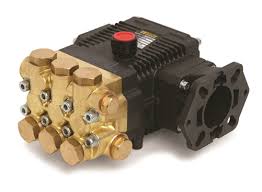Direct Drive Pumps
Direct Drive Pumps
A “Direct Drive” pump has a hollow shaft, which simply slides onto the drive shaft of a motor or engine. The flange on the pump is mounted to the face of the engine or shaft end of the motor. Normal gasoline engine speed is about 3450 RPM. Since the pump is connected directly to the engine shaft, the pump RPM is the same as the engine RPM. Electric motors typically will turn a direct drive pump at 3450 RPM or 1725 RPM. Direct drive pumps allow for a more compact designed pressure washer. Another advantage is that this drive system is simple, with fewer moving parts; therefore less expensive. The disadvantage is by having the pump spin as much as the engine or motor, the bearings and other parts get more wear and tear, reducing the life span of the pump. Direct drive pressure washers transfer the vibration of the engine or motor directly to the pump. Also, the faster pumps of direct drive pressure washers are spinning so fast that they cannot draw water from a tank very well. However, they tend to work just fine when the water is forced into the pump, like when it is hooked-up to a hose.
Benefits of Direct Drive:
- Compact Design
- Lower Acquisition Cost
Disadvantages of Direct Drive:
- Reduced Life Span
- Cannot Draw Water from Tank or Standing Water Source

